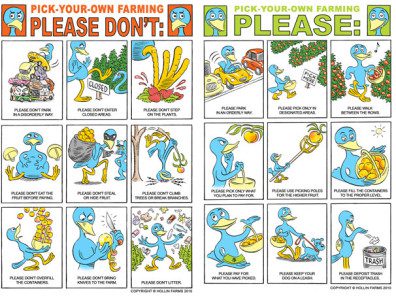

Nov 28, 2011Peach grower teaches customers with posters
When Tom Davenport first courted the ethnic market for his u-pick peach operation, he didn’t realize there would be a huge gap in what he expected from customers and what they expected from the u-pick experience. After a bumpy start, however, improved communication has resulted in a thriving customer base made up of immigrants from a number of countries.
Davenport and his son, Matthew, own Hollin Farm in Delaplane, Va.
“We’re part of a group of four orchards in six miles that we call the ‘Virginia Peach Way,’” Davenport said. “There’s synergy among us, so if one orchard is out of something they send the customer to another orchard.”
In the Washington, D.C., area where Hollin Farm is located, the three main immigrant groups are Indian, Chinese and Hispanic. Over the past 10 years, an increasing number of customers within all of these groups have come to the orchards. This has resulted in increased sales, but also increased friction between growers and customers who didn’t understand the concept of “u-pick” operations.
“Some groups would come with the idea that they were going to get free fruit,” Davenport said. “They weren’t used to the idea of mutual trust that is required for a u-pick operation to work. That was hard on everybody; it was hard on us, trying to patrol the situation, and it was hard on the customers who didn’t understand what they were supposed to do.”
As an example, Davenport used a story about a Bolivian family who came to Hollin Farms on a hot day in August.
“I saw a 12-year-old boy using one of our picking sticks to hurl peaches like lacrosse balls,” he said.
Davenport found the boy’s father and, in front of the family, lost his temper and made in issue of the boy’s behavior.
“Because I had the power, I told him to leave,” Davenport said. “I took away the peaches that he picked, and escorted him and his family out. I should have taken the father aside and spoken with him man to man, and not tried to humiliate him in front of his family. But I was hot and tired and I was sick of seeing these foreigners breaking rules that I considered obvious.”
For help, Davenport turned to Kim Stryker, a folklorist with the Smithsonian Folklife Festival who also is in the graduate program as George Mason University in Virginia. Her mission was to interview members of the immigrant community, find out why these incidents were occurring and find ways to resolve the friction between growers and customers.
“‘Pick-your-own’ is a novel concept to many of these groups,” Stryker said. “There was an expectation gap between what the farmers expected based on American-born customers, and foreign-born customers who had only a hearsay expectation of what pick-your-own means.”
What was being conveyed between members of immigrant groups, Stryker said, was something like, “There’s this place you can go with a lot of land, and nobody cares; you can go there and pick and eat whatever you want.”
“The intention of these people wasn’t to be thieves,” Stryker said. “They just thought that’s the way it worked; a lot of cultures have a ‘gleaning’ tradition where farmers allow people to come in and clean the fields after the harvest. A lot of people thought the growers had picked the best fruit already, and that’s why they were letting the people come into the orchard.”
After receiving the results of Stryker’s interviews, the Davenports came up with a unique way of communicating with non-English-speaking customers. Matthew made up a list of dos and don’ts, and the family hired artist Robert Grossman, a long-time friend and political cartoonist, to create graphics to communicate with these clients.
“Bob came up with the idea of using animals to illustrate the ‘rules’ for u-pick, and drew the cartoons,” Davenport said. “He used a big blue bird so he didn’t ‘profile’ anyone.”
The Davenports put the cartoons on posters, and also the bags customers use to hold the fruit they’ve picked.
The result was a relaxing of tensions on both sides. Ethnic customers understood more about what was expected of them, and the Davenports were able to stop prowling the orchard when immigrant families were picking fruit.
“We print them in English, and we’ve found that the children read them and translate them for their parents,” Davenport said.
Davenport is negotiating with two printing companies to make the “cartoon” posters and bags available to any u-pick operation that wishes to purchase them.
“I want to get them out where everyone can use them,” he said. “These rules will work for any operation, and help u-pick operations develop a market with immigrant populations in their areas.”
By Carolee Anita Boyles, FGN Correspondent














